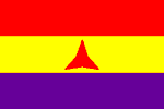Spain


Teniente Juan Lario Sanchez
Spain


Teniente Juan Lario Sanchez
Juna Lario joined the Republican air force in Spain, and in May 1937 was despatched to the Soviet Union for training at Kirovabad.
He was promoted to sargento on 20 November 1937.
On return from the Soviet Union, Lario was posted to the 4a/26 on 12 January 1938, flying I-15s.
A few days later, he was posted to the 2a/26, where he piloted Polikarpov I-15 no. CA-029.
On 21 February, all the serviceable Polikarpovs took off to try to oppose Nationalist bombers during the Battle of Alfambra.
At 10:20, Miguel García Pardo and Javier Allende Isasi of 2-G-3 took off on a routine reconnaissance flight over the Teruel front. There they discovered 20 I-15s and a similar number of I-16s in combat with a few Bf 109Bs. When García Pardo and Allende Isasi went to the assistance of the Messerschmitts, the German pilots failed to recognize them as allies and opened fire on them. They beat a hasty retreat, calling into battle another formation of Fiat CR.32s before continuing with their reconnaissance.
The new formation compromised 24 CR.32s of the XXIII Gruppo ”Asso di Bastoni” led by Maggiore Andrea Zotti. The pilots included the Spanish capitán Carlos Haya González who, after attending his mother’s funeral, arrived by car in Bilbao just as the group was about to take off. Despite Commander Zotti’s opposition, he insisted on taking his place in the formation.
At 11:04 over Teruel when they spotted about 40 Republican fighters split in three formations with I-15 “Chatos” at 3,500 and 4,000 meters, and I-16 “Moscas” at 5000 meters. The Republican fighters were already in combat with 17 Bf 109s. Zotti immediately chased them, and sent part of the Gruppo to attack the “Chatos”, which tried to evade as they were over Republican lines. At Puebla de Valverde, the “Moscas” intervened, but they were faced by the rest of the XXIII Gruppo, which at the end claimed two “Chatos” and a “Mosca” destroyed. One of the I-15s was claimed by Franco Lucchini of the 19a Squadriglia. In attempting to destroy an I-15 that was attacking another aircraft of his squadron, Carlos Haya González approached too close and collided with the I-15, falling to his death. It seems that this was sargento Francisco Viñals Guarro (I-15 CA-013) of the 2a/26, who managed to return despite the almost total destruction of the rudder (according the Republic bulletin, it was teniente Manuel Orozoco Ovira, of the 4a/26, who collided with Haya). Viñals’ I-15 was found to have a shattered aileron, badly damaged upper port wing and missing cockpit door and gunsight. Viñals’ promotion, recommended by the coronel Jefe de Fuerzas Aéreas and the Minister of National Defence, Indalecio Prieto, was effective from 22 February. The order was gazetted in the Diario Oficial issue No 47, which noted, ’For his heroic conduct in yesterday’s combats near Teruel, sargento del arma de aviación Francisco Viñals Guarro is promoted to teniente.’
Lario witnessed this combat. Haya fell near Puerto de Escadiòn, and was posthumously awarded with a Medaglia d’oro al valor militare.
The German pilots of J/88 claimed seven I-16s when 1 staffel claimed three near La Pueblé (Leutnants Fritz Awe, Hans-Karl Mayer and Erich Woitke) and 2 staffel claimed four near Sarrion and Teruel (Unteroffizier Herbert Ihlefeld, Leutnant Edgar Rempel, Unteroffizier Kurt Rochel and Staffelführer Oberleutnant Joachim Schlichting).
It seems that the Bf 109s had been in combat with twelve I-16s from 2a/21, which suffered three wounded pilots and one killed in combat with Messerschmitts and Fiats over Teruel in the morning while reporting 18 enemy aircraft downed (daily total?). Leitenant Aleksey Denisov (I-16 CM-034) claimed one Bf 109 before being shot down and had to bail out wounded. Leitenant Boris Adil’gireevich Takhtarov was wounded and badly burned when his aircraft (CM-123 or CM-239) caught fire after being hit by Bf 109s and he had to take to his parachute. When he jumped his parachute opened early, and on the way down the Germans tried to strafe him, but his comrades prevented them (he spent 35 days in the hospital and then returned home). The third wounded pilot was Andrey Belov. Leitenant Viktor Sergeevich Troshkin was killed while flying CM-032.
General Rojo advised Prieto, the Minister of Defence, that the Air Force had carried out three operations during the day, and that during the last of these they had been involved in a large-scale combat with the Nationalist Air Force. He later advised Prieto that according to information from Jerica (the Air Force’s command centre) five German aircraft – later stated to be five Bf 109s, seven Fiats CR.32s and one twin-engined aircraft had been destroyed. This message included the information that the ace pilot, Carlos Haya, who was reputed to have carried out the night attack on the War Ministry in Madrid, had been killed in this engagement. Their own losses were quoted as two I-16, which failed to return to base and two others, which were damaged and whose pilots were injured. Sergeant Manuel Orozco Ovira, who managed to fly his aircraft back to base after its tail had been destroyed, was recommended an award for outstanding bravery and skill.
The I-15s from the 2a/26 claimed three and two probable CR.32; these were claimed by Teniente Leopoldo Morquillas Rubio (CO) (1 probable), J. Mora Fauria, sargento Francisco Viñals Guarro, Fernando Villins León (1 probable) and C. Zuazo Garre. Francisco Montagut Ferrer from the 3a/26 claimed a Bf 109 while an unknown pilot from the 4a/26 claimed a CR.32. An unknown I-16 pilot from 1a/21 claimed a CR.32.
On 30 March, he was promoted to teniente.
In May, capitán Andrés García La Calle was ordered to form the Grupo No 28, which was equipped with Canadian Car & Foundry-built Grumman GE-23 Delfin biplanes that were to be used for ground attack and coastal patrol duties.
As CO, capitán García La Calle participated in the early stages of the battle of the Ebro, although in reality he did little flying as he was attached to the command post of general Rojo and coronel Modesto as Aviación liaison officer.
On 5 May, capitán José Riverola Grúas became deputy CO of the new Grupo de Asalto No 28, which was based at Cardedeu airfield.
During the month, Lario was posted to the Grupo and he remained at this unit until the end of the war.
During the Spanish Civil War he claimed seven victories.
After the fall of the government to Franco’s forces, he fled to France where he remained in several concentration camps until the end of May 1939.
He then emigrated to the Soviet Union, arriving in Leningrad on 7 June 1939.
In 1941, he served with a unit at Bikovo airfield, taking part in the defence of Moscow.
In June 1942, he was posted to Groznyi, and there he served with the 108 IAP.
He was later posted to the 127 IAP, and in December 1942 took part in the fighting at Stalingrad.
During 1943, he saw action over Kursk and Kharkov, and then over Kiev during the latter part of the year.
In 1945, he was with the 348 IAP, leading an eskadrilya of Spitfire Mk.IXs over Poland and Germany. During the fighting for Berlin, he operated for a time from Tempelhoff airfield.
By the end of the Great Patriotic War, he had flown 886 sorties and taken part in 97 engagements, which had allowed him to add 27 and 8 shared more claims to his Spanish Civil War total.
During the war he was decorated with the Order of the Red Banner, the Order of Patriotic War (1st and 2nd Class) and the Order of the Red Star (twice).
Lario ended the war with 7 biplane victories and a total of 34. All of the biplane victories were claimed during the Spanish Civil War.
He continued to serve in the VVS until 1948.
In January 1957 he returned to Spain.
He has written a book about his experiences: ”Habla un aviador del la República”
.
Claims:
| Kill no. | Date | Number | Type | Result | Plane type | Serial no. | Locality | Unit |
| 1938 | ||||||||
| 1 | ??/??/38 | 1 | Destroyed | Polikarpov I-15 | 2nd Escuadrilla de Caza | |||
| 2 | ??/??/38 | 1 | Destroyed | Polikarpov I-15 | 2nd Escuadrilla de Caza | |||
| 3 | ??/??/38 | 1 | Destroyed | Polikarpov I-15 | 2nd Escuadrilla de Caza | |||
| 4 | ??/??/38 | 1 | Destroyed | Polikarpov I-15 | 2nd Escuadrilla de Caza | |||
| 5 | ??/??/38 | 1 | Destroyed | Polikarpov I-15 | 2nd Escuadrilla de Caza | |||
| 6 | ??/??/38 | 1 | Destroyed | Polikarpov I-15 | 2nd Escuadrilla de Caza | |||
| 7 | ??/??/38 | 1 | Destroyed | Polikarpov I-15 | 2nd Escuadrilla de Caza |
Biplane victories: 7 destroyed.
TOTAL: 34 and 8 shared destroyed.
Sources:
Air War over Spain - Jesus Salas Larrazabal, 1974 Ian Allan Ltd, Shepperton, Surrey, ISBN 0-7110-0521-4
Fiat CR.32 Aces of the Spanish Civil War - Alfredo Logoluso, 2010 Osprey Publishing, Oxford, ISBN 978-1-84603-983-6
Soviet airmen in the Spanish civil war 1936-1939 - Paul Whelan, 2014 Schiffer Publishing Ltd, ISBN 978-0-7643-0
Spanish Republican Aces – Rafael A. Permuy López, 2012 Osprey Publishing, Oxford, ISBN 978-1-84908-668-4
Stalin's Falcons - Tomas Polak and Christhoper Shores, 1999 Grub Street, London, ISBN 1-902304-01-2
Wings Over Spain - Emiliani Ghergo, 1997 Giorgio Apostolo Editore, Milano
Additional information kindly provided by Victor Luis Alvarez, Fernando Ribes and Javi Roman Marin.


